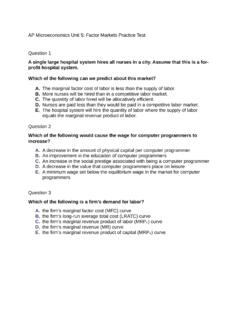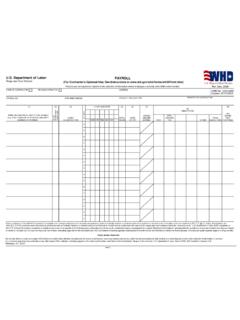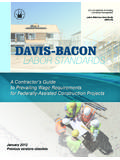Transcription of A Contribution to the Theory of Economic Growth Author(s ...
1 A Contribution to the Theory of Economic GrowthAuthor(s): Robert M. SolowSource: The Quarterly Journal of Economics, Vol. 70, No. 1 (Feb., 1956), pp. 65-94 Published by: The MIT PressStable URL: : 22/03/2010 10:04 Your use of the JSTOR archive indicates your acceptance of JSTOR's Terms and Conditions of Use, available JSTOR's Terms and Conditions of Use provides, in part, that unlessyou have obtained prior permission, you may not download an entire issue of a journal or multiple copies of articles, and youmay use content in the JSTOR archive only for your personal, non-commercial contact the publisher regarding any further use of this work. Publisher contact information may be obtained copy of any part of a JSTOR transmission must contain the same copyright notice that appears on the screen or printedpage of such is a not-for-profit service that helps scholars, researchers, and students discover, use, and build upon a wide range ofcontent in a trusted digital archive.
2 We use information technology and tools to increase productivity and facilitate new formsof scholarship. For more information about JSTOR, please contact MIT Press is collaborating with JSTOR to digitize, preserve and extend access to The Quarterly Journal Contribution TO THE Theory OF Economic Growth By ROBERT M. SOLOW I. Introduction, 65. - II. A model of long-run Growth , 66. - III. Possible Growth patterns, 68. - IV. Examples, 73. - V. Behavior of interest and wage rates, 78. - VI. Extensions, 85. - VIT. Qualifications, 91. I. INTRODUCTION All Theory depends on assumptions which are not quite true. That is what makes it Theory . The art of successful theorizing is to make the inevitable simplifying assumptions in such a way that the final results are not very sensitive.' A "crucial" assumption is one on which the conclusions do depend sensitively, and it is important that crucial assumptions be reasonably realistic.
3 When the results of a Theory seem to flow specifically from a special crucial assumption, then if the assumption is dubious, the results are suspect. 1 wish to argue that something like this is true of the Harrod- Domar model of Economic Growth . The characteristic and powerful conclusion of the Harrod-Domar line of thought is that even for the long run the Economic system is at best balanced on a knife-edge of equilibrium Growth . Were the magnitudes of the key parameters the savings ratio, the capital -output ratio, the rate of increase of the labor force - to slip ever so slightly from dead center, the conse- quence would be either growing unemployment or prolonged inflation. In Harrod's terms the critical question of balance boils down to a comparison between the natural rate of Growth which depends, in the absence of technological change, on the increase of the labor force, and the warranted rate of Growth which depends on the saving and invest- ing habits of households and firms.
4 But this fundamental opposition of warranted and natural rates turns out in the end to flow from the crucial assumption that produc- tion takes place under conditions of fixed proportions. There is no possibility of substituting labor for capital in production. If this assumption is abandoned, the knife-edge notion of unstable balance seems to go with it. Indeed it is hardly surprising that such a gross 1. Thus transport costs were merely a negligible complication to Ricardian trade Theory , but a vital characteristic of reality to von Thunen. 65 66 QUARTERLY JOURNAL OF ECONOMICS rigidity in one part of the system should entail lack of flexibility in another. A remarkable characteristic of the Harrod-Domar model is that it consistently studies long-run problems with the usual short-run tools. One usually thinks of the long run as the domain of the neo- classical analysis, the land of the margin.
5 Instead Harrod and Domar talk of the long run in terms of the multiplier, the accelerator, "the" capital coefficient. The bulk of this paper is devoted to a model of long-run Growth which accepts all the Harrod-Domar assumptions except that of fixed proportions. Instead I suppose that the single composite commodity is produced by labor and capital under the standard neoclassical conditions. The adaptation of the system to an exogenously given rate of increase of the labor force is worked out in some detail, to see if the Harrod instability appears. The price- wage - interest reactions play an important role in this neoclassical adjust- ment process, so they are analyzed too. Then some of the other rigid assumptions are relaxed slightly to see what qualitative changes result: neutral technological change is allowed, and an interest-elastic savings schedule. Finally the consequences of certain more "Keynes- ian" relations and rigidities are briefly considered.
6 II. A MODEL OF LONG-RUN Growth There is only one commodity, output as a whole, whose rate of production is designated Y(t). Thus we can speak unambiguously of the community's real income. Part of each instant's output is consumed and the rest is saved and invested. The fraction of output saved is a constant s, so that the rate of saving is sY(t). The com- munity's stock of capital K(t) takes the form of an accumulation of the composite commodity. Net investment is then just the rate of increase of this capital stock dK/dt or K, so we have the basic identity at every instant of time: (1) K = sY. Output is produced with the help of two factors of production, capital and labor , whose rate of input is L(t). Technological possi- bilities are represented by a production function (2) Y = F(K,L). Output is to be understood as net output after making good the depre- ciation of capital .
7 About production all we will say at the moment is THE Theory OF Economic Growth 67 that it shows constant returns to scale. Hence the production func- tion is homogeneous of first degree. This amounts to assuming that there is no scarce nonaugmentable resource like land. Constant returns to scale seems the natural assumption to make in a Theory of Growth . The scarce-land case would lead to decreasing returns to scale in capital and labor and the model would become more Inserting (2) in (1) we get (3) K = sF(K,L). This is one equation in two unknowns. One way to close the system would be to add a demand-for- labor equation: marginal physical productivity of labor equals real wage rate; and a supply-of- labor equation. The latter could take the general form of making labor supply a function of the real wage , or more classically of putting the real wage equal to a conventional subsistence level.
8 In any case there would be three equations in the three unknowns K, L, real wage . Instead we proceed more in the spirit of the Harrod model. As a result of exogenous population Growth the labor force increases at a constant relative rate n. In the absence of technological change n is Harrod's natural rate of Growth . Thus: (4) L(t) = Loent. In (3) L stands for total employment; in (4) L stands for the available supply of labor . By identifying the two we are assuming that full employment is perpetually maintained. When we insert (4) in (3) to get (5) K sFE(K,Loee ) we have the basic equation which determines the time path of capital accumulation that must be followed if all available labor is to be employed. Alternatively (4) can be looked at as a supply curve of labor . It says that the exponentially growing labor force is offered for employ- ment completely inelastically.
9 The labor supply curve is a vertical 2. See, for example, Haavelmo: A Study in the Theory of Economic Evolution (Amsterdam, 1954), pp. 9-11. Not all "underdeveloped" countries are areas of land shortage. Ethiopia is a counterexample. One can imagine the Theory as applying as long as arable land can be hacked out of the wilderness at essentially constant cost. 68 QUARTERLY JOURNAL OF ECONOMICS line which shifts to the right in time as the labor force grows according to (4). Then the real wage rate adjusts so that all available labor is employed, and the marginal productivity equation determines the wage rate which will actually In summary, (5) is a differential equation in the single variable K(t). Its solution gives the only time profile of the community's capital stock which will fully employ the available labor . Once we know the time path of capital stock and that of the labor force, we can compute from the production function the corresponding time path of real output.
10 The marginal productivity equation determines the time path of the real wage rate. There is also involved an assumption of full employment of the available stock of capital . At any point of time the pre-existing stock of capital (the result of previous accumula- tion) is inelastically supplied. Hence there is a similar marginal productivity equation for capital which determines the real rental per unit of time for the services of capital stock. The process can be viewed in this way: at any moment of time the available labor supply is given by (4) and the available stock of capital is also a datum. Since the real return to factors will adjust to bring about full employment of labor and capital we can use the production function (2) to find the current rate of output. Then the propensity to save tells us how much of net output will be saved and invested. Hence we know the net accumulation of capital during the current period.









